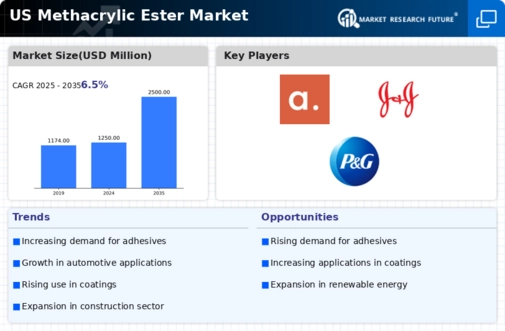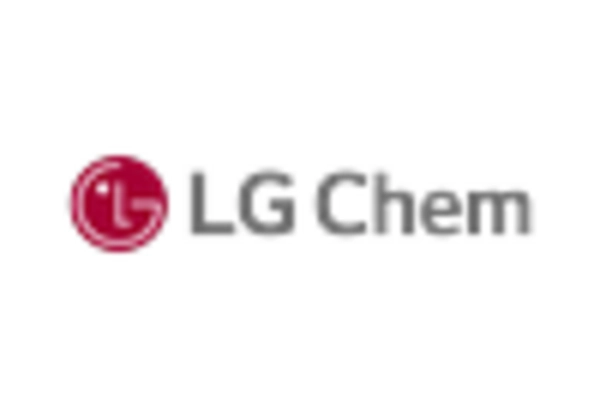Rising Demand in Automotive Sector
The automotive industry is experiencing a notable surge in demand for methacrylic esters, primarily due to their application in manufacturing lightweight and durable components. As vehicle manufacturers increasingly focus on enhancing fuel efficiency and reducing emissions, the use of methacrylic esters in coatings and adhesives is becoming more prevalent. The methacrylic ester market is projected to benefit from this trend, with estimates suggesting a growth rate of approximately 5% annually in this sector. Furthermore, the shift towards electric vehicles, which require advanced materials for battery casings and structural components, is likely to further drive the demand for methacrylic esters. This evolving landscape indicates a robust opportunity for growth within the methacrylic ester market, as automotive manufacturers seek innovative solutions to meet regulatory standards and consumer expectations.
Expansion in Construction Applications
The construction sector is witnessing a significant expansion, which is positively impacting the methacrylic ester market. Methacrylic esters are increasingly utilized in construction materials, such as sealants, adhesives, and coatings, due to their excellent adhesion properties and durability. The ongoing infrastructure development projects across the United States, fueled by government investments, are expected to drive the demand for these materials. Recent data indicates that the construction industry is projected to grow by approximately 4% annually, which could translate into increased consumption of methacrylic esters. Additionally, the trend towards sustainable building practices may further enhance the appeal of methacrylic esters, as they can be formulated to meet eco-friendly standards. This growth trajectory suggests a promising future for the methacrylic ester market as it aligns with the evolving needs of the construction sector.
Technological Innovations in Production
Technological advancements in the production processes of methacrylic esters are likely to play a crucial role in shaping the market landscape. Innovations such as improved catalytic processes and enhanced polymerization techniques are expected to increase production efficiency and reduce costs. The methacrylic ester market stands to benefit from these developments, as manufacturers can produce higher-quality products at competitive prices. Furthermore, the integration of automation and digital technologies in manufacturing processes may lead to increased output and reduced waste, aligning with sustainability goals. As production capabilities expand, the methacrylic ester market may witness a shift in supply dynamics, potentially leading to lower prices and increased accessibility for end-users. This evolution in production technology could be a key driver of growth in the methacrylic ester market.
Increased Focus on Research and Development
The methacrylic ester market is witnessing an increased focus on research and development (R&D) activities, which is expected to drive innovation and product diversification. Companies are investing in R&D to develop new formulations and applications that cater to emerging market needs. This emphasis on innovation is likely to result in the introduction of advanced methacrylic esters with enhanced properties, such as improved thermal stability and chemical resistance. Furthermore, collaboration between industry players and research institutions may lead to breakthroughs that expand the potential applications of methacrylic esters across various sectors. As R&D efforts intensify, the methacrylic ester market could experience accelerated growth, driven by the introduction of novel products that meet the evolving demands of end-users.
Growing Demand in the Paints and Coatings Sector
The paints and coatings sector is experiencing a robust demand for methacrylic esters, driven by their superior performance characteristics. These materials are favored for their excellent weather resistance, adhesion, and gloss retention, making them ideal for various applications, including automotive, industrial, and architectural coatings. The methacrylic ester market is projected to see a growth rate of around 6% annually in this segment, as manufacturers increasingly seek high-performance solutions to meet consumer expectations. Additionally, the trend towards eco-friendly formulations is likely to enhance the appeal of methacrylic esters, as they can be designed to comply with stringent environmental regulations. This growing demand in the paints and coatings sector indicates a favorable outlook for the methacrylic ester market, as it aligns with broader trends in sustainability and performance.

















Leave a Comment